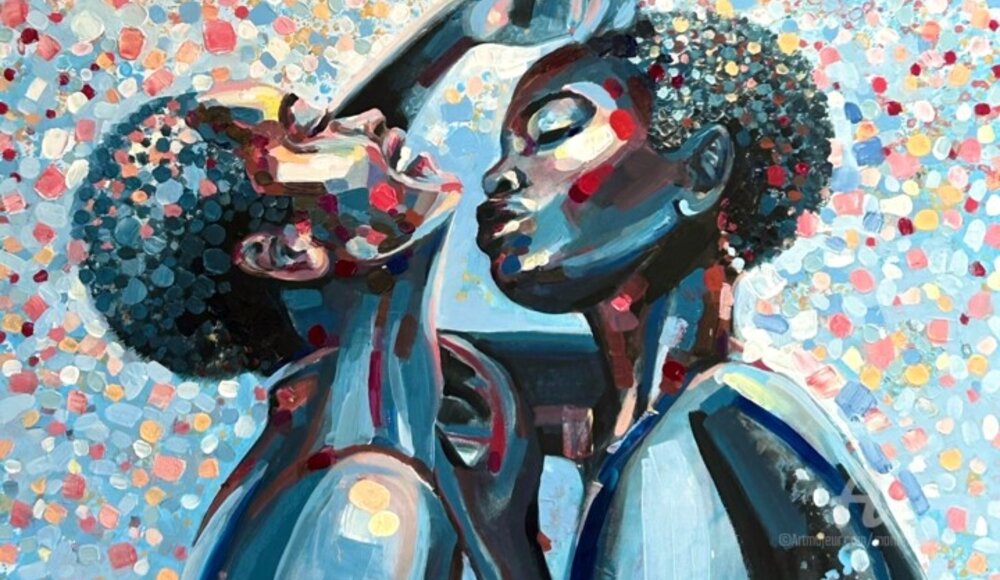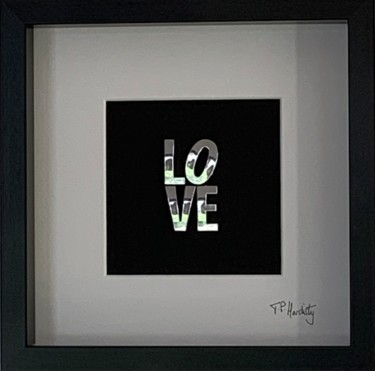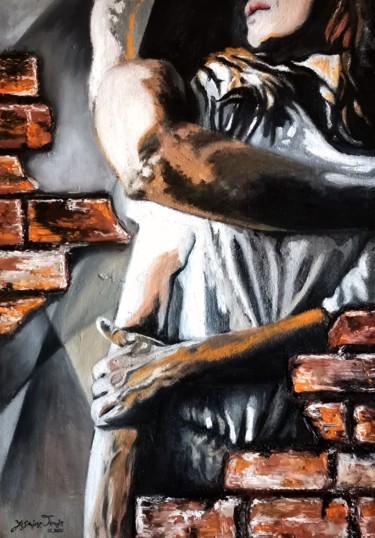 Julia Brinkfrau, Black lesbian couple, 2022. Acrylic on Canvas, 60 x 80 cm.
Julia Brinkfrau, Black lesbian couple, 2022. Acrylic on Canvas, 60 x 80 cm.
The clichés of love
When we come to the month of February, especially in the vicinity of the fourteenth, the many types of people in existence, whom we can imagine meeting at the bar, can be roughly summed up in four different human categories, such as: the perfect sweethearts, the love haters, the lonely hearts, the weeping widowers and those "strange" characters, who, having entered into symbiosis with their pet, prefer this relationship, driving out potential, boring and more complex candidates of the same breed. If I wanted to speak to all of these people, convincing even the most skeptical about the benefits of coupledom, I would show them a long repertoire of romantic masterpieces, surely including Francesco Hayez's The Kiss (1859), Antonio Canova's Love and Psyche (1787-1793), Egon Schiele's The Embrace (1917), etc. In reality, however, given that in our time "other" types of love, which fall outside the more "classical" as well as religiously favored "basic" bond between man and woman, also rightly claim legitimacy, I will try to capture the attention of even the most skeptical relationship hater or fan of the cute "man-Chihuahua" pairing by presenting a more contemporary love story that shatters several clichés in the name of the heartbeat. I am referring to one of Banksy's most provocative works: Kissing coppers (2004), a stencil aimed at depicting two British policemen, who, tightly embraced, exchange their saliva, in one of the most popular gestures among manifestations of mutual feeling. The work, which was initially created on the wall of The Prince Albert pub in Brighton, interprets the act of love in black and white, within a context expertly designed by the artist, as, the aforementioned British town, has been called the LGBTQ+ capital of the United Kingdom. If, with the above description, the love hater looks at me crookedly and the man-chihuahua is still skeptical about the benefits drawn from relationships between human beings, I would add, almost to convince them, that the power of love in Kissing coppers is not limited to just smooching, as Banksy has used this manifestation of feeling, to make himself a spokesperson for a social denunciation, aimed at condemning the homophobia that, to this day, invades the military world.
 Anatassia Markovskaya, Tender kiss, 2017. Acrylic on Linen Canvas, 120 x 90 cm.
Anatassia Markovskaya, Tender kiss, 2017. Acrylic on Linen Canvas, 120 x 90 cm.
The gestures of amorous abstractionism
In order to continue in my attempt to convert even the most refractory to the pleasures of love, I will seek an original way to recount how such feeling has manifested itself in art, while also referring to the "least popular" movement in this context: abstractionism. What has just been stated might seem somewhat absurd, since, despite the triumph of figurativism and its explicit, as well as classical, manifestations, the feeling of love still remains an inexplicable intangible concept, which, as a result, may well experience a more akin artistic investigation devoid of recognizable figures and blatant gestures. Trying, however, to integrate the multiple visions of love within a single and imaginative narrative, aimed at enhancing more or less exploited points of view, I will act, making use of an extravagant imagination, aimed at enabling me to find affinities between the clearest manifestations of figurativism and some of the abstract artworks of Artmajeur artists, which, present clear references to the most romantic world through their title, the words contained within them, the colors used, symbols, etc. In order to unveil this unprecedented procedure of analyzing works of art, based mainly on the search for "similarities," I will begin by slowly approaching Anatassia Markovskaya's Tender Kiss, an acrylic in which romantic intercourse is indicated by the very title of the work, the sentimental manifestation of which I believe is recognizable in the conspicuous, almost circular figure in orange color, as such chromaticism conveys all that typical erotic energy, aimed at propagating from the meeting of two mouths. Searching for the figurative "soul mate" of this abstract interpretation, I came across one of the most famous works on love of all time, namely Klimt's The Kiss (1907-08), within which a "same" circular form is presented, consisting of the head of the effigy, combining the decorations of her dress and her hair, in a small compositional nucleus that, in addition to housing the lovers' hands, also takes on part of the face of the lover, intent on kissing.
 Greg Thomas Bryce, The embrace, 2022. Oil on Paper, 25 x 25 cm.
Greg Thomas Bryce, The embrace, 2022. Oil on Paper, 25 x 25 cm.
Moving from kisses to embraces, Artmajeur artist Greg Thomas Bryce's The embrace reproposes, in its swirling brushstrokes, a probable wave-like motion of clasps between multiple lovers, who, in their passionality, do not deprive themselves of being, at times, even a bit cruel to each other, bringing to mind, with much imagination, the ruthlessness of Munch's vampire woman, or rather the passionate accomplice in the well-known painting Love and pain (1895). It is precisely this last masterpiece that depicts two lovers embracing, although, the flamboyant protagonist seems, at the same time, to kiss, or bite, her partner on the neck, giving rise to an intercourse that the artist reproduced in six versions, made between 1893 and 1895. At this point a question arises, can abstractionism, as opposed to figurativism, perhaps conceal more, or rather keep almost hidden, the explication of the suffering brought by love? Certainly, the use of color and the manner in which it is drafted mean a great deal in terms of the viewer's emotional involvement, but perhaps, what is narrated, if not made explicit in the title, can always come across as very labile, personal and subjective, consequently less direct and immediate than the canonical depiction of reality. In addition, man has always been accustomed to giving form, both to good and evil, abstract concepts that only then has figurativism made clear and stereotyped in the human imagination. Turning to another manifestation of love, I will now consider a gesture, which, though more demure, is intended to make explicit without hesitation the existence of an affective bond between two people: I am speaking of the most "practical" meeting between the hands of lovers, that is, the simplest, most natural and obvious shaking hands, an action which, when performed in front of the gazes of the couple's most stubborn antagonists, such as insidious and multiple suitors, seems to quietly shout the claim of a legitimate right of "ownership." At this point, to make a bit of irony, I might quote the Discourse on the Origin and Foundations of Inequality, in which Rousseau, who, states how private property is the origin of all inequality, seems almost to understand all the complaints of those people who cannot hold the hand of those who are, perhaps, already happily taken. Wishing the latter to find the half-apple or the simpler and more profitable mental serenity, I take the liberty of quoting, as a kind of good omen, Rubens' Self-Portrait with his wife Isabella (1609-1610), a work in which the artist celebrates his union with the young woman through a languid clasping of their hands. Briefly describing the masterpiece, the elegantly dressed protagonist wears a sumptuous gown composed of a damask bodice, embellished with a jacket of shiny, embossed black fabric and a long skirt that entirely covers her legs, candling on the grass. In contrast, Rubens is seated higher up, a position from which he offers his hand to his companion, while, behind them dominates the background a flowering honeysuckle, a plant symbolizing conjugal love, which is made explicit in the serenity of their faces.
 Maria Esmar, By your side, 2022. Oil on Canvas, 61 x 61 cm.
Maria Esmar, By your side, 2022. Oil on Canvas, 61 x 61 cm.
How to translate such a masterpiece through a work, in this case, somewhere between abstractionism and expressionism? The most pertinent example is offered by Maria Esmar's oil painting, or By Your Side, in which the two floral protagonists are reminiscent of the aforementioned figures with hats, who, likewise, are positioned side by side, ready to cross every storm, or rather drought, given the context, together!
 Stacy Boreal, Sex, 2021. Acrylic on Linen Canvas, 160 x 100 cm.
Stacy Boreal, Sex, 2021. Acrylic on Linen Canvas, 160 x 100 cm.
Finally, the last gesture to which I will pay attention represents the actual carnal union of the two beloved ones, aimed at manifesting itself in the eternally talked-about sexual act, which, the acrylic by Artmajeur artist Stacy Boreal, has depicted by means of two interlocking figures, symbolically arranged on top of each other, as a kind of snapshot aimed at proceeding the moment of mating. Such interpretive finesse is strongly opposed within the contemporary art narrative by Jeff Koons' pseudo-pornographic point of view, explicated in his well-known and controversial Made in Heaven series, which, conceived to be a response to today's objectification of the human body, simulated the different modalities of the sexual act using the artist's ex-wife Ilona Staller and Koons himself as subjects of investigation. In choosing himself as the protagonist, the American artist pursued the goal of giving his figurative research a greater semblance of veracity, reality, controversy and intimacy, aimed at converting the shame with which we often speak of sex into a more rational view of the act, which, after all, is part of human existence and survival.
 Alla Grande, Lve_Pplypthychon_2, 2022. Lacquer on Canvas, 57 x 57 cm.
Alla Grande, Lve_Pplypthychon_2, 2022. Lacquer on Canvas, 57 x 57 cm.
The symbols and colors of love abstractionism
As anticipated, love is itself a concept, which we usually manifest through certain sensations and motions, which can be indicated by specific words, symbols and colors, which, once again, bring us back to the more abstract nature of love. The peculiarities of the latter view's approach on sentimentality can be found in the abstractionism of Love_Polypthychon_2, a painting by Alla Grande, which uses the strategic subdivision of the four words, intended to constitute the term love, in order to create a greater visual impact, enriched by the presence of colorful and vivid backgrounds, which are revealed behind each vowel or consonant. Such a optician stratagem seems to invite the viewer to scan well the word he reads, in order to focus more on its meaning, reflecting on the concept that underlies the life of every being on earth. On the other hand, in regard to the telling of the art story, the "similarly spelled out" word "love" brings one back to Robert Indiana's iconic sculpture, while, in regard to the striped, partly psychedelic backgrounds, they could perhaps represent the "fusion" of views on the line of Sean Scully and Victor Vasarely. For the purpose of inviting you to be aware of what has just been stated, I believe, in particular, that the artist in Artmajeur possibly drew inspiration from Scully's Blue (1981) and Vasarely's Vonal-Stri (1975).
 Isabelle Pelletane, Only love, 2022. Acrylic on Canvas, 60 x 60 cm.
Isabelle Pelletane, Only love, 2022. Acrylic on Canvas, 60 x 60 cm.
Speaking of symbols, on the other hand, I believe that without a shadow of a doubt the heart is the most popular image that man has devised to express the idea of love, probably referring to the fact that when we like someone the beats of this organ increase dramatically. In reality, however, not only the heart undergoes a change, as, more often than not, our hands begin to shake, we sweat more, our pupils dilate, the tone of our voice changes, etc. Perhaps it was distasteful to draw sweat to depict a noble feeling? Besides, how is the sweat symbol made? Okay, leaving such nonsense aside I'll get to the point, which is the work of Artmajeur artist Isabelle Pelletane, who in her acrylic Only Love has "endlessly" multiplied a series of hearts on the paint medium, repeatedly celebrating this well-known symbol of love. Responding to his point of view, however, is the history of figurative art, which, in even unhappy works outside the context of love, such as Botticelli's Extraction of the Heart of Saint Ignatius (1488) and Enrique Simonet's The Autopsy (1890), has proudly shown some of the peculiarities of this organ capable of love, failing to mere symbolic simplification.
 Thia Path, I love red, 2022. Acrylic on Canvas, 100x100 cm.
Thia Path, I love red, 2022. Acrylic on Canvas, 100x100 cm.
Finally, we come to the color red, the symbol of passionate feeling par excellence, which has characterized a multitude of abstract works, but without necessarily making itself the bearer of affective meanings. An example of the above is Mark Rothko's Untitled (Red) (1969), which, rather than a declaration of love, seems to be a stylistic manifesto, aimed at repurposing the typical areas of main colors, which, intended to fill most of the canvas, distance themselves from the narrow borders, having the intention of keeping the figures slightly separated. Finally, in contrast to the U.S. master, I Love Red, a work by Artmajeur artist Thia Path, again links, just as per the title, red to the concept of love, so much so that in this case the painter exposes her feeling toward the same passionate hue.


 Olimpia Gaia Martinelli
Olimpia Gaia Martinelli























